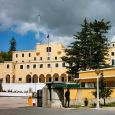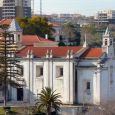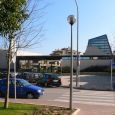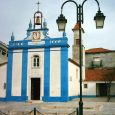Sacavem
Advertisement
By road
The Northern Highway (A1), which links Lisbon to Oporto (with one output node in Sacavem that redistributes traffic to Vasco da Gama Bridge, IC2, CRIL and Second Circular );
The Vasco da Gama Bridge, which allows access to the motorway n. No. 12 (A12) (linking Montijo to Setúbal up to A2 );
The Supplementary Itinerary. 2 (IC2), which connects the Sacavem Moscavide to South, and Santa Iria de Azoia to North ;
The Supplementary Itinerary. No. 17 (IC17) (also known as CRIL (Inner Belt Road Lisbon) or A36), which establishes the connection - still incomplete by the absence of section Buraca / Pontinha - between Sacavem and Alges ;
The National Highway no. No. 10, which connects the Sacavem Vila Franca de Xira and thence to the Setúbal Peninsula );
The National Highway no. No. 250, which connects to the seat of the county Sacavem, Loures ;
The National Highway no. 6-1/Estrada º n City. No. 504, which connects the Sacavem Moscavide (Rua Cidade de Goa);
Chapel of Our Lady of Health and St. Andrew
The Chapel of Our Lady of Health and St. Andrew, commonly known as syncopated Chapel of Our Lady of Health or the Shrine of Our Lady of Health is a small temple situated in Sacavem, the area known as Sacavem Angle, isolated in a off which corresponds to the historic city - the Five October Largo, formerly known as Health Largo, Largo Chapel or the Chapel Yard.
Convent of Our Lady of Martyrs and Conception of Miracles
The current monastery of Our Lady of Martyrs and Miracles of Conception, located in the parish of Sacavem, instead of Sacavem Low, based on where they were formerly the ruins of an ancient chapel dedicated to Our Lady of Martyrs, whose foundation tradition attributes to D. Afonso Henriques, after the legendary Battle of Sacavem. Today is the headquarters of Battalion Attache of the Portuguese Army.
Church of Our Lady of Purification
The Church of Our Lady of Purification is the current Church of Sacavem, situated on a small hill in Sacavem Low, near the river Trancao. Initially founded as a convent church of the Convent of Nossa Senhora da Conceicao and Martyrs Sacavem, designed to serve the religious services to the nuns of St Clare therein professed, its first stone was laid by Miguel de Moura, then governor of the Kingdom of Portugal on behalf of Philip II of Spain, on September 1st of 1596. Even before the same Miguel de Moura was responsible for building the said convent in 1577, however, died in 1599, before seeing the church completed.
Museum of Ceramics Sacavem
The Museum of Ceramics Sacavem is a space museum in the town of Sacavem, to preserve the old core of Sacavem Cookware Factory (the celebrated once the city), centered around the furnace no. 18.After the failure of cookware factory in 1994, the Municipality of Loures ruled (in a meeting on November 22 of 1995 ) the construction of a museum center that made the history of that factory and its production of ceramics, situated on the grounds where once this had risen
Church of Our Lady of Victory
The Church of Our Lady of Victory was the former Church of Sacavem, located at the end of Old Right Road in Sacavem Angle.At the site where today stands the Church of Our Lady of Victory lifted the Visigoths in the fifth century of our era, a small chapel dedicated to Our Lady of Joy. It was therefore the first church in town, having subsisted during the occupation of Muslim, thus showing the Christians perform acts of worship, upon payment of a tax as the attacker.
House-Museum Jose Pedro
The House-Museum Jose Pedro was established as the second core museum city Sacavem linked to the activity ceramics. Established in the potter's place of residence of Jose Silva Pedro, a former employee of the factory Cookware Sacavem, the House Museum, located in n. 8 of Street Fighters of the Great War, intended to preserve the estate that the ceramic artist has been creating over the last twenty years of his life, mainly from homes and small porcelain figures.
Parque do Tejo and Trancao
The Parque do Tejo and Trancao is a landscaped garden in Nations Park, situated geographically in the eastern part of the parish of Sacavem. It was established following the International Exhibition of 1998, and includes green space limited by the Tagus River, the source, the river Trancao the north, the line of Azambuja, west, and Vasco da Gama Bridge, south, covering an area approximately 90 hectares. The margin facing the Tagus River is an ecosystem type marsh.
Vasco da Gama Bridge
The Vasco da Gama Bridge is a bridge over the Tagus river in the area of Greater Lisbon, linking Montijo and Alcochete to Lisbon and Sacavem very close to the Park of Nations, where he held the Expo 98. Inaugurated on March 29th of 1998, the bridge is the longest in Europe and is currently the ninth most extensive of all the world, with its 17.3 km length, of which 12 are on the waters of the Tagus estuary. At its inauguration was served paella which was entitled to entry in Guinness World Records.
Quinta de Sao Jose
Quinta de Sao Jose is an old farmhouse situated in manor Sacavem - the only one of many that once existed in the parish, to arrive today. Its elevation North faces the street Julio Bruno da Costa Pereira, the South for Augusto Ferreira Plazza Geirinhas and raised West is opposite to the Northern motorway (A1).
Fort Sacavem
The Mount Redoubt-Cintra (or Monte-Sintra) commonly known as Fort Sacavem, located in the parish and city of Sacavem, county of Loures, District of Lisbon in Portugal. Situated on the right bank of the river Trancao in Sintra called Mount whence comes the name, a few 800 meters from its confluence with the River Tagus, its construction dates back to the nineteenth century, in the context of works of fortification of Lisbon, which formed the Entrenched Field of Lisbon, rolling on top of a small hill about 35 feet high and thus taking a strategic position that involves the entire surrounding space.
Siphon Canal Alviela
The Siphon Canal Alviela or Arc Alviela Canal in Sacavem, is a structure of civil engineering remarkable for its architecture, built under the Aqueduct Alviela, and intended to supply with the waters of the Rio Alviela, the city of Lisbon and the counties adjacent.
September - November






